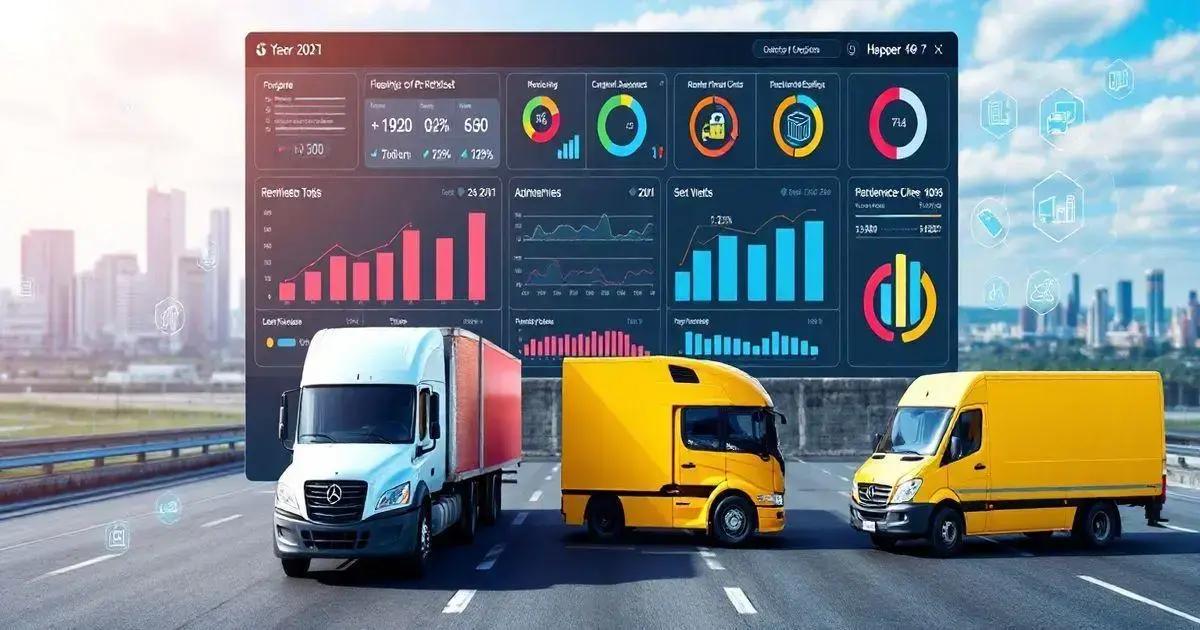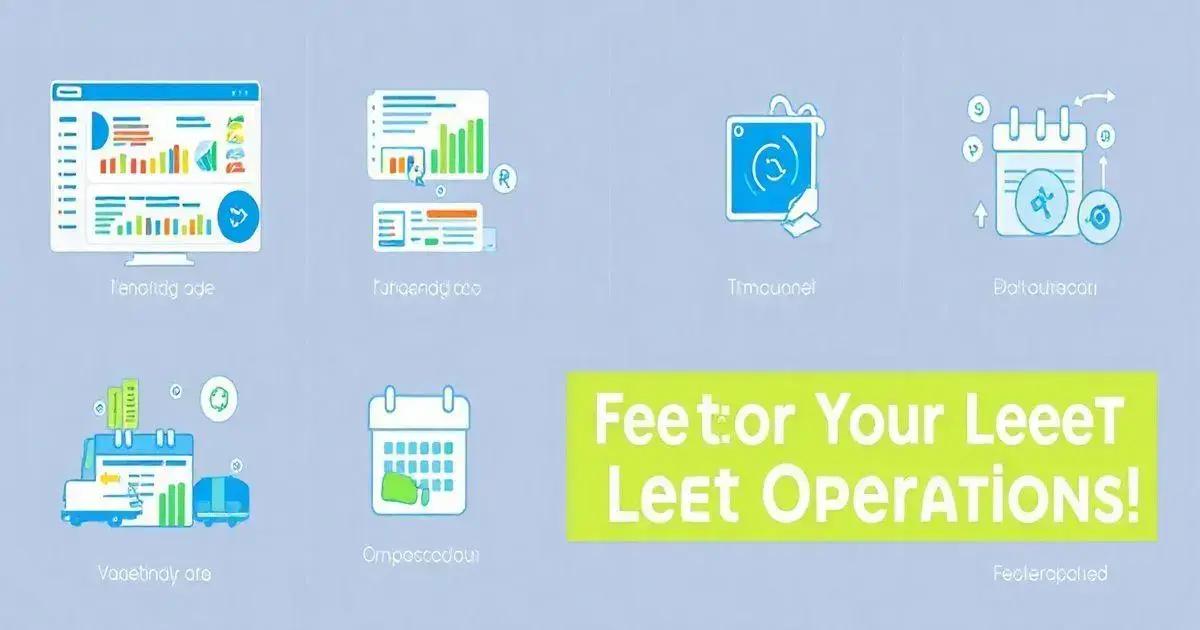7 Key Features of Fleet Control Worksheet 7.0 Leave a comment
The Fleet Control Worksheet 7.0 is a vital tool for fleet management, offering features for tracking vehicle performance, maintenance, and costs. It includes dashboards for monitoring kilometers, fuel efficiency, and maintenance expenses, along with vehicle and driver registration, cargo tracking, tire management, and maintenance control. This comprehensive solution enables fleet managers to analyze yearly performance and make informed decisions to enhance efficiency and reduce costs.
The Fleet Control Worksheet 7.0 is an essential tool for anyone looking to streamline their fleet management. With features designed to improve efficiency, track expenses, and manage vehicle maintenance, this worksheet provides intuitive dashboards and powerful data analysis.
Are you ready to take control of your fleet’s operations?
Initial Dashboards Overview
Initial Dashboards Overview
The Fleet Control Worksheet 7.0 comes equipped with several key dashboards that provide valuable insights into your fleet operations right at your fingertips. Here’s what you can expect:
- KM by Driver: Track the total kilometers driven by each driver, allowing you to monitor performance and optimize routes.
- KM per Vehicle: Analyze how much each vehicle has been utilized, helping you assess vehicle efficiency and potential overuse.
- KM per Liter: This metric helps understand the fuel efficiency of your vehicles. It assists in identifying any anomalies in performance that may require further investigation.
- KM per Trip: Evaluate the distance covered during individual trips to find patterns or areas for improvement in route planning.
- Average Consumption per Vehicle: Calculate the average fuel consumption for each vehicle, which can uncover opportunities to improve fuel efficiency.
- Average Consumption per Driver: Similar to the vehicle consumption metric, this gives insights into fuel efficiency at the driver level.
- Total General, Preventive and Corrective Maintenance: Monitor all types of maintenance performed on your fleet, ensuring that vehicles are kept in optimal condition.
- Maintenance Cost Average: Keep track of the average costs associated with maintenance, allowing for better budgeting and financial planning.
- Total cost of Mechanical and Electrical Maintenance: Understand what you are spending on mechanical and electrical repairs, enabling more informed decision-making about vehicle upkeep.
- Total Tire Maintenance Cost: This metric tracks all expenses related to tire management, helping to ensure that you’re not overspending in this area.
- Total Lubricant Cost: Similar to tire costs, keeping tabs on lubricant expenses allows for better inventory management and purchasing decisions.
- Average cost of Mechanical and Electrical Maintenance: Helps gauge the average repair costs over time, which is essential for forecasting future expenses.
- Average Tire Maintenance Cost: Gauge what you typically spend on tire management, ensuring you’re getting good value.
- Average cost with Lubricants: Track average lubricant expenses to improve purchasing strategies and inventory control.
- Vehicles in Transit: Know the status of your vehicles at any moment, enhancing security and operational efficiency.
- Tires in Transit: Keep track of tire inventory that is in transit, which is crucial for timely replacements.
- Delayed Vehicle Documents: Stay updated on which vehicle documents are delayed, ensuring compliance and preventing legal issues.
- Delayed Driver Documents: Monitor the status of driver documentation to ensure all are up-to-date and legal.
- Delayed Preventive Maintenance: Identify any overdue preventive maintenance tasks, helping to avoid costly breakdowns.
- Total Cost Versus Shipping: Analyze total operation costs against shipping revenue to ensure profitability.
- Fuel, Maintenance and Other Costs: A comprehensive look at all costs associated with running your fleet, facilitating better budget management.
These dashboards serve as a powerful tool for any fleet manager, providing actionable insights that can streamline operations, reduce costs, and enhance overall fleet management.

Vehicle and Driver Registration
Managing a successful fleet requires precise and organized records for both vehicles and drivers. The Fleet Control Worksheet 7.0 simplifies the process by offering dedicated sections for vehicle and driver registration.
Here’s a breakdown of what you can expect:
- Driver Registration: This section allows you to input essential information about each driver, including:
- Name: Full name of the driver for identification.
- License Number: Record the driver’s license number to ensure compliance with legal requirements.
- Contact Information: Keep a record of phone numbers and email addresses to facilitate communication.
- Experience Level: Document the driver’s experience, which can help in assigning vehicles based on skill.
- Emergency Contact: Capture details for emergency contact to ensure safety on the road.
- Vehicle Type Registration: For effective fleet management, you can register each vehicle with detailed information, including:
- Vehicle ID: Unique identifier for each vehicle in your fleet.
- Make and Model: Record the make and model to assist in maintenance and repairs.
- Year: Document the manufacturing year for warranty and insurance purposes.
- License Plate Number: Essential for legal compliance and tracking.
- Vehicle Type: Categorize the vehicle type (e.g., truck, van, sedan) to facilitate better planning and management.
- Current Mileage: Track the mileage to schedule maintenance and monitor vehicle performance.
- Insurance Details: Keep records of insurance policy numbers and coverage details for each vehicle to ensure compliance and readiness in case of incidents.
- Maintenance History: Document past maintenance work and repairs for each vehicle, enabling easier tracking of service intervals.
Having all this information organized in one place not only enhances operational efficiency but also ensures compliance with regulations and safety standards. The intuitive layout of the Fleet Control Worksheet 7.0 makes it easy to maintain accurate records, thereby streamlining communication and decision-making throughout your fleet management processes.
Ultimate Travel Control
In the realm of fleet management, maintaining control over travel logistics is paramount. The Fleet Control Worksheet 7.0 offers a comprehensive suite of features designed to help fleet managers efficiently oversee all travel-related activities. Here’s how it empowers you:
Ultimate Travel Control
- Cargo Control Linked to Trips: This feature allows you to associate cargo details with specific trips. You can monitor:
- Type of Cargo: Identify the goods being transported to ensure proper handling and compliance.
- Weight and Volume: Keep track of the cargo’s weight and volume to optimize load distribution and vehicle usage.
- Delivery Schedules: Set and adjust delivery timelines to improve customer satisfaction and operational efficiency.
- Vehicle Control: Maintain a clear overview of which vehicle is assigned to each trip, tracking:
- Vehicle Assignment: Easily assign vehicles based on availability and suitability for the cargo.
- Current Location: Monitor where your vehicles are at any given time during their trips.
- Status Updates: Keep track of the vehicle’s status, whether in transit, unloading, or facing delays.
- Driver Control: Manage driver assignments seamlessly by keeping records of:
- Assigned Drivers: Know which driver is responsible for each trip.
- Driver Availability: Track driver schedules to avoid conflicts and ensure compliance with driving hours regulations.
- Performance Monitoring: Assess driver performance metrics, such as on-time deliveries and fuel efficiency.
- Supply Control: Manage all supplies needed for each trip, including:
- Fuel Management: Keep records of fuel purchases and consumption to optimize fuel costs.
- Maintenance Supplies: Ensure that essential maintenance items are available on the road to avoid breakdowns.
- Control of All Travel Expenses: This feature encapsulates all expenses associated with travel, allowing you to track:
- Fuel Costs: Monitor fuel expenses to identify trends and areas for savings.
- Toll and Parking Fees: Keep a detailed log of additional travel costs to accurately assess overall trip expenses.
- Driver Expenses: Manage and reimburse drivers for expenses incurred during travel, which helps maintain morale and accountability.
The Ultimate Travel Control feature of the Fleet Control Worksheet 7.0 ensures that every aspect of your fleet’s travel operations is effectively managed. By having all relevant data at your fingertips, you’re empowered to make informed decisions that enhance efficiency, reduce costs, and improve service delivery.

Comprehensive Tire Management
Effective tire management is crucial for fleet safety, performance, and cost efficiency. The Fleet Control Worksheet 7.0 includes a dedicated section for comprehensive tire management that allows fleet managers to track and optimize tire usage effectively. Here’s how it works:
Comprehensive Tire Management
- Identification for Each Tire: Each tire in your fleet is assigned a unique identifier, enabling you to:
- Track Tire History: Keep detailed records of each tire’s service history, including purchases, replacements, and repairs.
- Monitor Performance: Evaluate tire performance based on usage and condition to ensure optimal fleet safety.
- Tire Change Schedule by KM: This feature helps you manage tire replacements based on mileage, ensuring:
- Timely Replacements: Reduce the risk of tire blowouts and improve vehicle safety by adhering to replacement schedules.
- Cost Management: Plan for tire purchases in advance, helping you manage budgets effectively.
- Signal of How Much KM is Left to Change the Tire: By tracking mileage against tire wear, you can:
- Predict Replacement Needs: Anticipate when tires will need to be replaced, allowing for better inventory and budget planning.
- Minimize Downtime: Schedule replacements during maintenance windows to reduce disruptions in operations.
- Status per Action: Manage tire status through various actions including:
- Allocate to Vehicle: Assign specific tires to vehicles as needed, optimizing usage.
- Remove from Vehicle: Track tires that are taken off vehicles for maintenance or replacement.
- Scrap: Efficiently manage the disposal of worn-out or damaged tires, adhering to environmental regulations.
- Maintenance: Schedule regular checks on tire condition, ensuring they are safe for use.
- Comprehensive Reporting: The tire management module provides detailed reports that include:
- Tire Expenses: Keep track of all costs associated with tires, including purchases, maintenance, and replacements.
- Performance Metrics: Analyze how tires are performing across the fleet to identify potential issues or outliers.
- Wear Patterns: Monitor wear patterns to spot problems early, allowing for proactive maintenance.
With the Comprehensive Tire Management feature in Fleet Control Worksheet 7.0, you ensure that every tire investment is maximized, extending the life of your tires, enhancing safety, and ultimately saving costs. This proactive approach to tire management not only improves operational efficiency but also contributes to the overall reliability and performance of your fleet.
Efficient Maintenance Control
Maintaining your fleet’s vehicles is essential for optimal performance and longevity. The Fleet Control Worksheet 7.0 offers robust features for Efficient Maintenance Control, allowing fleet managers to streamline maintenance processes and ensure that vehicles are always road-ready. Here’s how:
Efficient Maintenance Control
- Corrective and Preventive Maintenance Type: The worksheet distinguishes between:
- Preventive Maintenance: Scheduled maintenance tasks designed to keep vehicles running smoothly and prevent breakdowns.
- Corrective Maintenance: Unscheduled repairs needed to address vehicle issues that arise.
- Maintenance by Vehicle: Track maintenance records for each vehicle in your fleet, enabling you to:
- Monitor Service History: Keep an accurate log of maintenance performed, including oil changes, tire rotations, and inspections.
- Identify Trends: Analyze maintenance data to spot recurring issues with specific vehicles, allowing for proactive measures.
- Maintenance by Mechanical and Electrical Type: Differentiate between system-specific maintenance tasks, including:
- Mechanical Checks: Regular inspections of the vehicle’s mechanical components like brakes, engines, and suspensions.
- Electrical System Maintenance: Track the upkeep of electrical systems to ensure proper functioning of lights, batteries, and other electronics.
- Maintenance Cost: Keep detailed records of all maintenance expenses, which helps in:
- Budgeting: Plan for future maintenance costs by analyzing past expenditure patterns.
- Cost Reduction: Identify areas where savings can be achieved, such as optimizing service contracts or reducing unnecessary repairs.
- Preventive Maintenance Schedule: Create a rotating schedule for preventive maintenance tasks that includes:
- Service Reminders: Automated alerts for upcoming maintenance tasks based on mileage or time intervals.
- Task Assignments: Easily assign maintenance tasks to specific personnel or service providers.
- Preventive Maintenance Signal: This feature helps you:
- Track Completion: Monitor whether scheduled maintenance tasks have been completed on time.
- Evaluate Delays: Identify trends in delayed maintenance tasks to improve scheduling and resource allocation.
- Status by: Easily view the current status of maintenance tasks as:
- Scheduled: Tasks that are planned but not yet completed.
- Accomplished: Completed maintenance tasks that ensure vehicle readiness.
- Delayed: Tasks that were scheduled but not completed in the designated time frame.
With the Efficient Maintenance Control features in the Fleet Control Worksheet 7.0, fleet managers can enhance operational efficiency, reduce downtime, and extend the life of their vehicles. By keeping maintenance organized and proactive, you ensure that your fleet remains safe and reliable, ultimately leading to cost savings and improved service delivery.

Yearly Analysis and Reporting
Yearly Analysis and Reporting
In the fast-paced world of fleet management, having a clear understanding of your yearly performance metrics is crucial for making informed decisions. The Fleet Control Worksheet 7.0 includes a dedicated section for Yearly Analysis and Reporting, providing valuable insights to guide your strategies moving forward. Here’s what you can expect:
- Total Travel: This metric provides a comprehensive overview of:
- Distance Covered: Measure the total kilometers driven by your fleet over the year, helpful for assessing vehicle utilization and route efficiency.
- Trip Frequency: Analyze how often trips are made to understand operational patterns and driver workload.
- Cost with Preventive and Corrective Maintenance: Keep track of all maintenance-related expenses, including:
- Preventive Maintenance Costs: Evaluate how much was spent on scheduled maintenance to keep vehicles in optimal condition.
- Corrective Maintenance Costs: Assess expenses incurred from unscheduled repairs to identify any underlying issues.
- Fuel Consumption: Analyze fuel usage across the fleet to monitor:
- Fuel Efficiency: Identify patterns in fuel consumption that can highlight areas for improvement.
- Cost Trends: Understand how fuel costs impact your overall budget and operations.
- Fuel Cost: Examine the total amount spent on fuel over the year, allowing you to:
- Identify Trends: Spot fluctuations in fuel prices that could affect budgeting.
- Optimize Fuel Usage: Implement strategies to reduce consumption and save costs.
- KM Run: Track the total distance run by the fleet to support:
- Performance Benchmarking: Compare yearly data to assess improvements or declines in performance.
- Vehicle Maintenance Scheduling: Plan maintenance based on actual usage to avoid unnecessary wear and tear.
- Average KM per Liter: Calculate fuel efficiency on a broader scale to:
- Benchmark Performance: Compare efficiency across different vehicles or drivers.
- Identify High Performers: Recognize which vehicles are operating most efficiently and why.
- KM per Maintenance: Analyze the relationship between distance traveled and maintenance performed to:
- Optimize Maintenance Schedules: Ensure timely maintenance based on actual usage patterns.
- Reduce Downtime: Prevent breakdowns by proactively scheduling maintenance before issues arise.
- Total Cost: Summarize all operational costs, including:
- Maintenance Costs: Both preventive and corrective, to provide a full picture of fleet expenses.
- Fuel Costs: See how fuel consumption impacts your overall budget.
This Yearly Analysis and Reporting feature in the Fleet Control Worksheet 7.0 empowers fleet managers to make data-driven decisions. By analyzing historical performance metrics, you can identify trends, optimize operational efficiencies, and strategically plan for the upcoming year. Ultimately, this thorough approach helps maintain a competitive edge while ensuring your fleet operates at its best.
Conclusion
The Fleet Control Worksheet 7.0 is a vital tool for any fleet manager looking to enhance operational efficiency and maintain a high-performance fleet.
From comprehensive tire management to efficient maintenance control and detailed yearly analysis, this worksheet equips you with the resources needed to effectively monitor and manage every aspect of your fleet.
By utilizing these features, you can not only streamline your operations but also reduce costs and minimize downtime, ensuring that your fleet remains reliable and productive.
With its user-friendly design and powerful functionalities, the Fleet Control Worksheet 7.0 is more than just a tool; it’s an integral part of your fleet management strategy that promises to deliver tangible results.
Embrace the power of organized data, informed decision-making, and proactive management with the Fleet Control Worksheet 7.0. Start optimizing your fleet today!
FAQ – Frequently Asked Questions about Fleet Control Worksheet 7.0
What is the Fleet Control Worksheet 7.0?
The Fleet Control Worksheet 7.0 is a comprehensive tool designed for fleet management, helping users track vehicle maintenance, driver performance, fuel consumption, and more.
How can I track maintenance expenses with this worksheet?
The worksheet allows you to log all maintenance costs, categorize them into preventive and corrective maintenance, and analyze your spending over time.
Is the worksheet suitable for all types of fleets?
Yes, the Fleet Control Worksheet 7.0 is versatile and can be used for various fleet types, including light and heavy vehicles.
Can I customize the dashboard to fit my needs?
Absolutely! The worksheet is designed to be user-friendly, allowing you to customize dashboards and reports based on your specific requirements.
How does the tire management feature work?
The tire management feature tracks each tire’s history, maintenance schedule, and costs, helping users manage tire usage and replacements effectively.
Do I need any special software to use the worksheet?
The Fleet Control Worksheet 7.0 is compatible with standard versions of Excel, so you can use it on any computer that has Excel installed.

